
Science
Prologue
How it began
I have to thank my mother for being interested in Astronomy. I remember I saw in the newspaper The First Step On The Moon, 1969. But I found the newspaper boring and throw it away. Next day mother bought the same newspaper. I regret and cut new news out, starting to collect paper clips in a binder. When it was full, I started to white a book, in Swedish, starting from atoms and finished with astronomy. Since that book got several hundred references, I found I cold never contact any book publishers. But today, with a home page, it is possible to show my collections. And mother still interested of astronomy.
It is strange how the scientists names things.
An electron has a negative charge. But nothing is missing. It is not the same as you are missing some money. It is just that something negative is opposite something positive.
In the middle of an atom each proton or neutron consist of three quarks. A proton has the charge +1 and the neutron has the charge 0. Now we have to divide +1 in three parts.
And the three quarks has the colour red, green and blue, which together makes white, just as the LEDs in the computer screen. But we can not see any colour in this small scale: the width of the light waves are much bigger than an atom.
And even more odd things. Some other quarks is called Strange and Charm. I wonder how a quark can be charming.
I also added my own theories.
The German succeed in spring 2013 split the light beam in three parts, i.e. split the electron in three parts. But I still miss what is counting to 2-8-8-18 a s o of the quantity of electrons in an Atom. I think we missing some particle(s), a "counter".
And the twin theory. If you send a twin in a space rocket, the twin staying on earth will grow older much faster than the other. You can change the twins to two watches. But what tells the watch onboard the space rocket to slow down the time?
Swenglish
Apologize for Swedish text in some 20 years old pictures. I am not in the mood for redoing them.
Apologize for bad translation. It is either mine Swenglish or Google translate.
Atom
Already some hundred years BC the Greek had a theory, that the atom may be pulled apart.
The alchemists tried to create gold, but failed. But we can create gold today, by sending protons into lid. But that gold will be more expensive than normal gold.
An atom has one or more protons in the nucleus. And zero or more neutrons. And normally same amount of electrons as protons.
Hydrogen has one proton and one electron. Link
Helium has two protons, two neutrons and two electrons. Link

Lid has 82 protons. Bigger atoms are unstable, radioactive. This is fission. Link
When smashing two atoms together, for example merge two Hydrogen atoms together to create Helium, it is fusion. That is what happen in the sun.
Big atoms has appr. 1,5 times more neutrons than protons.
The size of an atom is 10-8 cm. If you have a rod of one meter, you can cut it in one half. Cut one half in a quarter and so on. When doing that 37 times you have an atom.
The nucleus is 10-14 cm. If you repeat cutting the halves in a new halves 9 times more, you have only the nucleus in the atom.
The electrons in an atom circulates in orbits. The first layer has only two electrons. Next layer has 8. Next has 8. Next has 18. But I am asking what is counting the numbers of electrons in a layer?
If we taking on electron from an atom, we have an electrical charge, static electricity.
If an outer layer for example consists of only 7 electrons in an atom, but next atom has 1, we have an chemical reaction. Link
Atoms seven states
The three normal is solid, liquid and gas. The state of the two former is called the solidification or melting, normally called melting point; between the other two states is called condensing or evaporating (or called boiling).
The temperatures for the melting point and boiling point will be different for different atoms: this in turn depending on the pressure that the substance is exposed.
Mercury is a metal that is liquid at room temperature.
Nitrogen is liquid when the gas is cooled or compressed enough.
Frozen steam will not necessary be fluid: it can be ice directly and called snow.
Mountaineers have problems, because a warming drink might unfortunately already boils at 90°C.
Frozen carbon dioxide does not melt: in normal air pressure evaporates the ice directly: it is therefore called for dry ice. Link
Helium can never be in solid form.
By a certain temperature and pressure a material is between solid, liquid and gas at the same time.
The three more states:
At 0,0000001°K all atoms moves so slow that all atoms merges and behaves as a single unit, a super atom. The condition is called BEC, Bose-Einstein condensate.
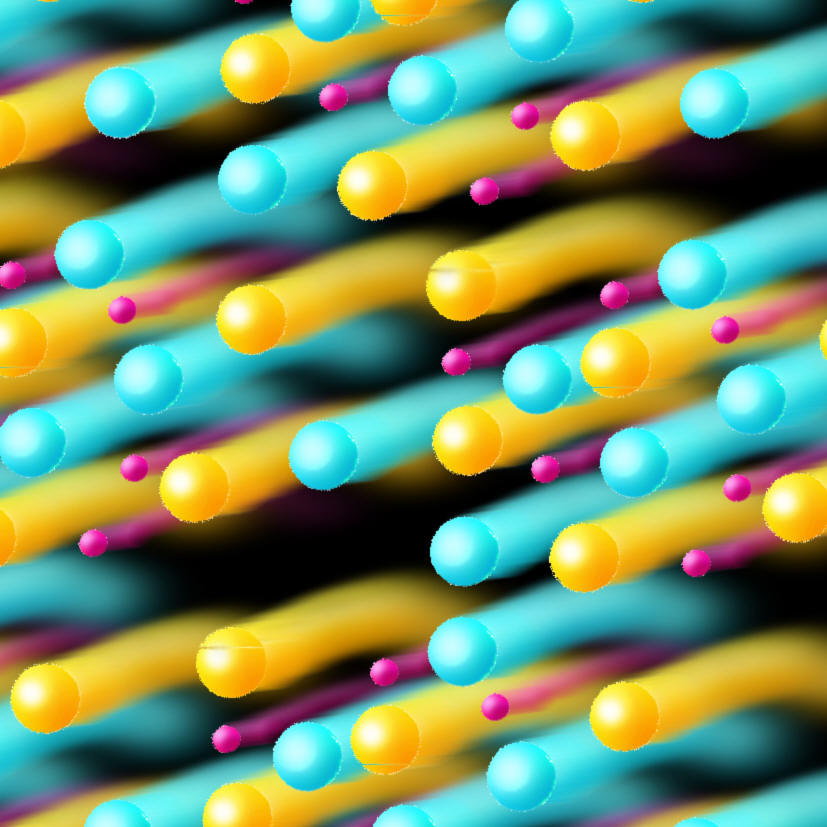
At the highest temperatures the atoms are divided: the particles are completely free. The condition is called plasma.
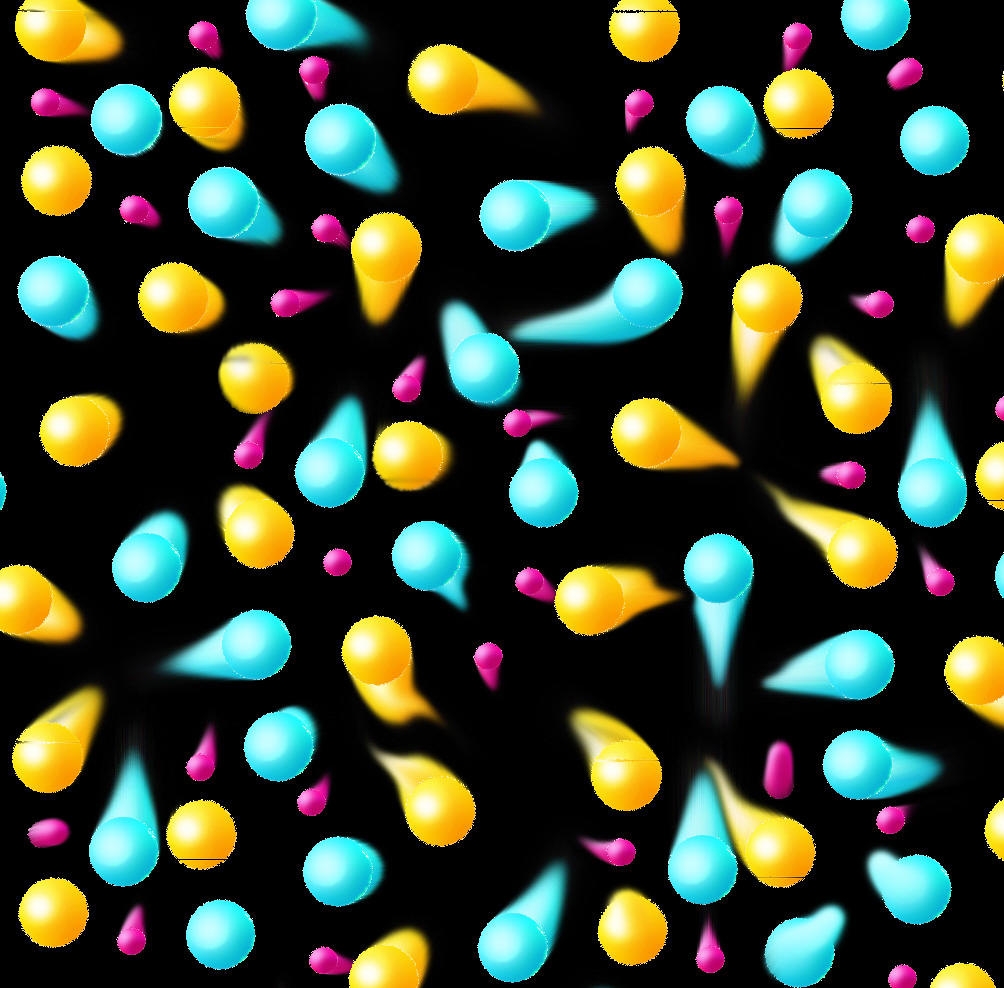
And the seventh state: A substance can be liquid in two different ways, depending on the pressure. Phosphorus may be fluent in two different ways. Water may be the same: a mixture of several distinct fluids, depending of pressure.
Periodic table
.svg/770px-Periodic_table_(polyatomic).svg.png)
Where the last two rows, lanthanides and actinides should be placed inside the big table.
We can see the first row in the table got room for 2 electrons, matching the first layer of eletrons in an atom.
Next row in the table got room for 8 more electrons in the next layer in an atom.
Then 8 more again.
Then next 18 more and so on.
Another way of representing the periodic system is a diagram in a spiral shape, created by Theodor Benfey. Link

Oxygen, nitrogen, silicon and carbon are the substances most readily form chemical compounds.
Iron rusts easily, but an alloy of iron, chromium and nickel is used for stainless steel, (or so called: it rusts anyway).
The metals do not oxidise are gold, silver and titanium. Titanium is used for tools in surgery, as it is a lightweight, relatively strong metal that does not oxidize. Titanium is also used for sports cars and aeroplanes for Mach 2-3.
Different elements have different voltages. Two electrodes (anode and cathode) of different materials in a liquid of acid or diluted acid, occurs a galvanic cell or battery.
In the same way you can embellish objects, place a thin layer of gold on brass details or galvanize iron details. Where one element steals from the other. Zink heals damage. But a small aluminium part will vanish on a big stainless steel part. Sometimes you do not need acid, only contaminated water: a Zink plate, anode, works for boats made of Iron. But a Zink anode does not works for cars, since the rain is too less contaminated: you have to galvanize big parts of the car, or the whole car.
And if you have a machine with different cooling pipes made of copper, brass, aluminium and stainless steel, not so uncommon, you will have a very big problem.
The hydrogen atom mass is 1.66 * 10-24g.
Different metal oxides uses to produce colours. Potassium and cadmium gives red and yellow colour material: titanium, zinc and lead, gives white; chrome gives blue and green; iron gives red and yellow; cobalt gives blue. Gold oxide gives red. When colour TV stared in the 60s, they used gold oxide in the screen.
With a covalent bond between two identical nuclei, as two Oxygen nuclei, the distance between the two nuclei is 0.7 atoms. In a metallic or crystalline structure, the distance between two atoms, for example iron, is 1.2 atomdiametrar.
Crystalline structure of metals
The crystalline structure is different for different metals, but also different depending of pressure and cooling time.
Compare the different options, how to stack oranges! If you have ten oranges, you can stack them into a tetrahedron: you get when six oranges in the first layer, three in the second and one on top.
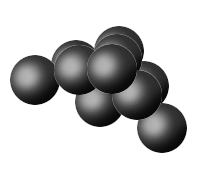
You can also stack 14 oranges, so you put nine in the first layer, four in the
second and one on the top: this forms a pyramid.
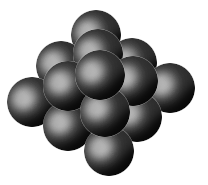
Or you can stack 14 oranges, so you put seven
in the first layer and seven in the second layer.

Forging (hammering), bending or cutting the material, one atomic layer slides a little bit: about one atom at a time, but sometimes also an half atom.
To prevent atomic layers from sliding, you mix in other types of atoms, smaller and/or larger: This is known as alloy
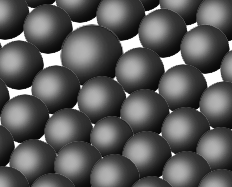

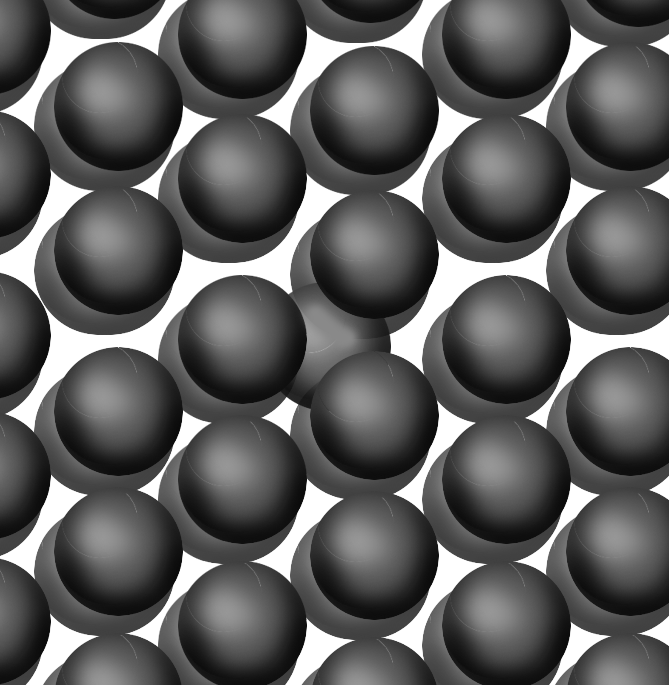
Forging, rolling, drawing, annealing and tempering will transform deformed crystal formations. Irregular crystal bonds makes the material ages.
In the spider silk is every molecule in the correct position. Therefore spider silk is stronger than steel.
You can not take a photo of an atom. But with a needle with a charge you can "feel" the atomic structure.

Or you can push one atom at a time. Link to the smallest movie in the world.
In this micro word the material is no longer recognizable. Gold ceases to gleam, to be electrically conductive and being resilient. On the other hand, a very thin glass is as flexible as a plastic film. The transition between the macro and micro values is gradual.
Carbon balls
If you have an almost perfect sphere, but with 12 plane pentagon shaped surfaces, you have a dodecahedra. If you place a carbon atom in every corner of those pentagon shapes, you have an carbon ball, called Fullerene.
You can add 12 hexagonal plane surfaces to that carbon ball. In every corner of a pentagon or a hexagonal, you can place a carbon atom. You have 60 carbon atoms.
You can continue adding hexagonal pieces, but you still need 12 pentagons. And placing a carbon atom on every corner.
You can also have a carbon nano tube.
Transparency
A solid substance is generally not transparent. In metals the electrons can be excited: thus absorbed all light.
Glass and some kinds of plastic are transparent. This is because the electrons are so tightly chemically bound in the material, that they let a passing image to be largely unaffected. In general, there are not so many transparent plastics as you might think: but they are transparent as thin films.
Some cheramics may be transparent. Link
Solidification point of glass
For most elements and chemical compounds is a certain temperature, when the substance hardens . The larger molecules, the more diffuse is the solidification point. But this is clear: once the atoms are located in crystalline forms, the subject is solid , otherwise it is floating.
A tall tale is that glass still is floating, since in old windows the panes is thicker in the bottom than in the top. But it was the glazier who put them like that. However, a pane glass is still floating, but it will take millions of years to make the bottom thicker.
Water and ice
Water is heaviest at +4°C . This is why there may be life on earth : at the bottom of frozen lakes , water can still flow. In ice the molecules are crystalline and taking more space.
The transition between water and ice can occur quickly. A waterfall does not freeze immediately, because the molecules' kinetic energy can prevent crystal formation. Icing can start at the points of the waterfall where the molecules move slowest, such as near rocks and bridge abutments. As soon as the ice formation started, the entire waterfall can be frozen in one hour.
If you prevent molecules from placing themselves in crystal form , the subject is still afloat. Chalmers researchers made water still flow at -150°C.
It is a myth, when you drain a bath tube, the vortex always going anti clockwise in north and clockwise in the south. This phenomenon is called Coriolis force. It exists, but to weak to observe in the bath tube. If you have a very big bath tube the rotation speed of the vortex will be 0.05 mm / s, if the bath tube is placed at one of the earth poles.
Snowflakes becomes hexagonal because of the chemical structure . Although three- and twelve- edged snowflakes occur.
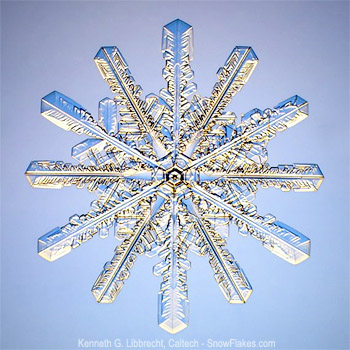
To preserve a snowflake you take (still outdoors) a drop of super glue on the snowflake.
Water and oil can not normally mix. If you mix these two liquids while stirring vigorously, it is called emulsion. An example of an emulsion is dressing. An Australian researcher discovered that if you remove all the air from the water, the liquid can be mixed with oil.
For heavy water is hydrogen nucleus replaced by deuterium. We see no difference between normal and heavy water. In conventional water is a deuterium atom per 6000 ordinary hydrogen atoms. Heavy water freezes at 3.8 ° and boils at 101.4 °. Heavy water can be easily made with electrolysis. Link
Rainbow
Rainbow is formed by sun beams, reflected three times in every water drop . The arc is always 42 ° to the sun. If you are in a high altitude and the sun is low , you can see a whole rainbow . From the centre has the rainbow colours violet, indigo, blue, green, yellow, orange and red. In fact, the rainbow has an almost infinite amount of colours, but the number seven is sacred.
Light can also be reflected four times in water drop and create a secondary rainbow. This rainbow is more pale than the first one. The order of the colours are reversed. It has 51 °to the sun.
An upside-down rainbow exist too, but this is made from ice crystals : it's a halo phenomenon.
Diamonds
Diamonds are carbon. Difference between diamond and coal is that a diamond atom has four short strong bonds to the four nearest atomic neighbours. Diamond burn as well as carbon. Diamond is the hardest substance. It leads sound and heat very well. A diamond is fragile. Link
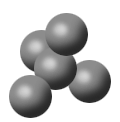
Linear Expansion
All material expands when it gets warmer. Metal expands in the heat, you can see the stretched wires: wires of the power line is always hanging down more in the summer than in the winter. Also concrete expands in heat: a bridge kilometres long expands a few meters.
Rails also expands by heat, but you can prevent the extensions by big closely spaced strong concrete sleepers and heavy staples.

Magnetic materials
In iron, also compounds with cobalt and nickel, but also pure metals as nickel and manganese, location of the atoms can be changed. Some atoms in the material then turns, so they get similar directions of spin.
When looking for non magnetic metals in the soil, such as gold, gold miners put it in an external magnetic field: the metals becomes weakly magnetic: the phenomenon called diamagnetism. Link
Carbon balls, carbon-oxygen-nitrogen compounds may be slightly magnetic, even plastic and sugar become magnetically.

Vacuum and air
We normally don't think of it, but the air pressure on our bodies are equal to a 760 mm high column of mercury.
It's hard to say how it feels to be the victim of vacuum, as no surviving it and can report. The blood in the veins boils, saliva evaporates from the tongue, belly swells, the air goes out of the lungs.
A balloon filled with hydrogen or helium floats in the air. It wants to float on top of the atmosphere. If you place such a balloon inside a car, it floats up to the ceiling. But when braking the car, the balloon go backwards, not forwards. The air in the car is heavier than the balloon. The air is pushed toward the windshield. NOTE! Be careful and think about your and others' safety on the road, if you intend to try these experiments!
Quantum mechanics
The laws of physics, such as location and speed of objects are the same in the micro and macro world.
However every you can not have too small packages: this is the quantum mechanics. A photon is the smallest element that can exist for a light beam. You can not send a light with a half photon. Link
You can measure the temperature of water in a bath tube by a thermometer, where the thermometer get the same temperature as the water. But if you measure only a drop of water, the water will probably get the same temperature as the thermometer.
In the micro world you are not really sure of a position: one thing might be in two possible places at the same time. In quantum computers we have no 0 and 1. When we measure, it could be 0 and 1 at the same time. Quantum computers works very fast. Link
More in the atoms
How to create antiparticles
The recipe is quite simple. You starts with a beam of protons that bombard a metal plate. The collision creates a lot of different mass particles running in different directions. Some of them are protons and anti protons. They are created in pairs and trying to be reunited, generating energy.
By using strong magnets you can separate particles from anti particles. By bending the beam with other magnets you can separate the anti protons, because they have negative charge and a mass different from other particles. The anti protons remain isolated in vacuum bottles, fitted with strong magnets: as soon as they come into contact with ordinary matter, they will disappear and generate energy again.
What protons and neutrons consist of
In fusion scientists discovered that two protons may collide with each other, where one converted to a neutron. Also two small particles creates: a positron and a neutrino. Also heat is created. Fusion is going on in the sun.
Scientists found that protons and neutrons are composed essentially of three particles. They called them quarks. A quark is 10-15 cm. If an atom is as big as the Earth, becomes a quark size of a ping-pong ball.
| Neutron | Proton | Anti Proton |
 |
 |
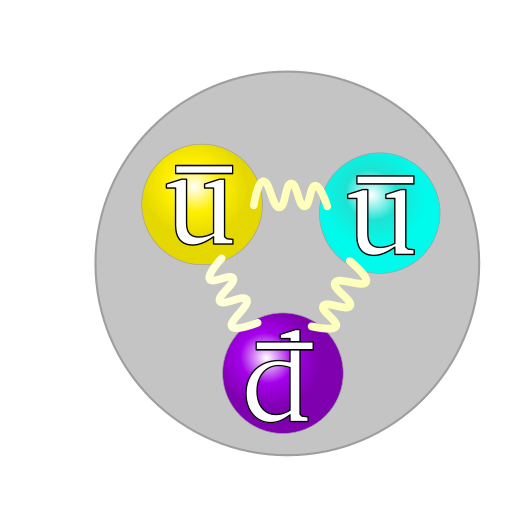 |
| Link | Link |
We can see three quarks in a Neutron or a Proton has the colours red, blue and green. If we mix those colours we got white.
A Neutron has two down-quarks and one up-quarks, a Proton the opposite.
The anti matter is marked with a line above the text. And the colours are negative in the picture for anti quarks.
Any particle consist of more than one quark is a Hydron. Gluon binds the quarks together.
Particles made of two, four or five quarks exist, but are not stable. Five quarks in a particle calls Theta-plus.
Up and Down is the spin direction of quarks.
Quarks with higher energy levels exist in space: this is called cosmic radiation. Those quarks are called Strange and Charm.
Even higher energy levels of quarks called Top and Bottom.
We have six types of quarks. Plus six types of anti quarks.
The electron is made of particles called leptons. They are also six different types of leptons, the corresponding three different high energy levels of the quarks. And their anti leptons. An anti electron is called a Positron.
Link particles
Link quarks
With these 24 particles with its signalling messenger, gluons and photons (light), the researchers understand how the universe is built. It has thus been given explanations of what is radioactivity, fusion and electromagnetism.
Higgs particle causes gravity. This particle is called a Boson. Link.
Interesting to know: Peter Higgs only used note papers and whiteboard, never computers.
What quarks consist of
Scientists have made discoveries, which shows that the quarks consist of even smaller units. The particles should have a diameter of the order of 10-18 cm. If our atom was scaled up to the size of the Earth, a quarks ingredients consist of particles that are 0.2 mm.
In a particle accelerator at Fermi lab in Chicago scientists have found that collisions between particles occurs at low energy levels, resulting the number of jets is expected. At high energy levels, however, the number of jet streams are too large, indicating that the quarks consisting of minor ingredients.
Combining quarks and anti quarks
Such combinations is called mesons. They are held together by the strong force. Mesons have a lifetime of between 10-8 - 10-20 Seconds.
There are nine possible combinations of two quarks, including anti quarks.

All combinations of quarks are called hadrons. Hadrons called mesons, since they consist of two quarks, or baryons, since they consist of three quarks.
Baryons
We already know four types of baryons: proton, anti-proton, neutron and antineutron. A single proton or anti proton are stable. A single neutron or anti neutron has a lifespan of only 917 seconds.
Some baryons are much heavier than the proton.
Since we have 12 types of quarks, we get about 100 possible combinations of three quarks:
uud, udu and duu is for example the same particle
while uud, uud, uud, uud, uud and uud are different.
Matter and anti matter
We already told you how anti protons are created.
Scientists accelerated anti protons and let the particles collide with xenon atoms. It formed of bursts of different particles. Some of the particles were positrons. Some positrons merged with anti protons and created anti hydrogen. The problem is that the anti hydrogen is neutral charged and impossible to keep in a magnetic field. The record to keep the anti hydrogen is 16 minutes.
By cooling the anti hydrogen to 1°K, the scientist got time to weight the anti hydrogen before it hits any normal matter: the gravity of anti hydrogen seems to be plus or minus 100 normal hydrogen matter (read: the gravity could be plus or minus).
More peculiar particles
Besides matter and antimatter we have super symmetric particles. When protons and antiprotons collide, it created an electron and a positron and two photons. But the four created particles had less energy than what was applied: The missing mass was exactly two electrons, but not detectable.
So we adding our table with one column for theoretical particles:
| Matter | Antimatter | Super Symmetric partner or Spartner |
| Quark | Anti-Quark | Squark Link |
| Electron | Positron | Selectron Link |
|
Photon |
Photino Link | |
|
a s o |
||
Neutrinos
As mentioned above, some particles from the sun are neutrinos. Also from space and from exploding stars (supernovas) sending neutrinos.
As quarks have three different high energy levels , there are also three corresponding neutrinos has various high energy levels : electron neutrino, myon neutrino and tau neutrino.
One problem the neutrino is electric neutral, has almost no mass and interact mostly nothing with other materials. Most neutrinos passing though the Earth and your body without interact.
However neutrinos react with chlorine 37, creating the radioactive isotope argon 37. If you have a tank with chlorine 37 and found argon 37, you know neutrinos was detected.
The sun sends out only one kind of neutrinos, electron neutrinos. Every second, it sends out 2*1038 neutrinos. On their way to earth, some electron neutrinos transforms to myon neutrino or tau neutrino. Transformation can only happen if neutrinos have mass.
The myon neutrino or tau neutrino is even more hard to detect.
And of course we have to add one row in our table
| Matter | Antimatter | Super Symmetric partner or Spartner |
| Neutrino | Anti-neutrino | Sneutrino Link Link |
Spin
If an object is completely asymmetrical, it must be rotated 360o to look the same again. It has spin 1.
Ace of Spades must be rotated one turn to look the same again. It has spin 1.
King of Spades need only to be rotated a half turn to look the same again. It has spin 2.
Bosons has spin is 0, 1 or 2.
However, there are particles that must be rotated two turns to look the same again. Fermions have half-integer spin. Link Link
And of course we have to add one row in our table
| Matter | Antimatter | Super Symmetric partner or Spartner |
| Fermions | Anti-fermions | Sfermions Link |
Leptoquarks
Normally the quarks are in the nucleus with electrons (leptons) in orbit around the nucleus. However you can join the leptons in the nucleus. Such particles is called leptoquarks. Link
What electrons consists of
You can split the electrons too.
With a powerful X-ray beam hit a metal plate, scientist found they could split the electrons in two parts: a spinon carrying the spin and an orbiton carrying its orbital moment - the motion around the nucleus.
The scientist also succeed to split the electrons in a third part, Holon, the electrical charge.
What I wrote in the prologue I still looking for an explanation what is counting the number of electrons in the layers in the nucleus: 2-8-8-18 a s o.
Colours and eyes
Among all the different wavelengths of electromagnetic waves, is a small area, which we call colours. This area can be perceived by our eyes. This is called "optical window". Waves longer than the red, are heat waves. Waves shorter than violet are ultraviolet and X-ray waves.
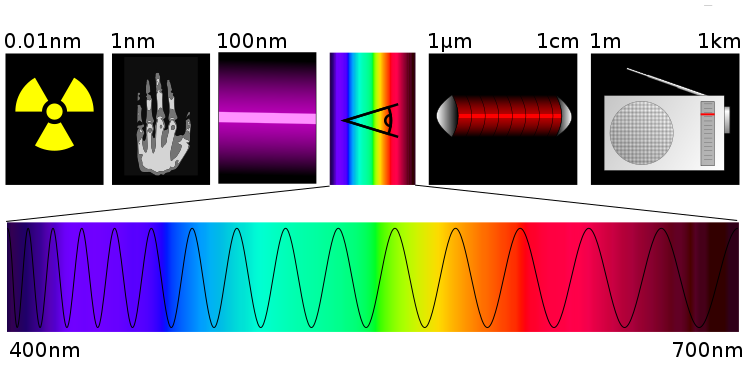
Snakes can even perceive heat waves,
Insects can also perceive ultraviolet light: some birds and mammals can also perceive ultraviolet light. Link

Human who got their eye lenses removed, perceive ultra violet light: Famous artist changed their way to paint when they got their eye lense removed. Link Claude Monet
The fished have four kinds sensitive cells in their eyes (retina). In diagram above: ultra violet (as grey), blue, green and red. Observe one type of cell is more or less sensitive to a colour. Observe the equal distance of colours in the diagram.
Since ultra violet light has very high energy, the lenses normally filter the UV light out. But small birds are still able to see UV light, since their eyes are to small to get damaged from UV light. Also parrots and raptors are able to see UV light, since it helps them hunting.
Almost all mammals can only see two colours, blue and green. They can not se a yellow tiger on green grass, neither a hunter in yellow or red clothes.
With the help of genetic engineering scientists have inserted a gene from a human, so that laboratory mice can also see red colours.

In the monkeys eyes and also our eyes the sensitive sells can see blue, green and red.
A mix of green and red in TV and computer screens are perceived as yellow.
You can paint the heat radiator in any kind of colour, black or white. It does not matter. But the colour must glow in infrared light!
If you want to take UV or IR photos, which is in some way possible with an ordinary digital camera, you need filters to filter out visible colours: those filters are dark blue, dark red or even black.
In the picture below I have R, G and B channels, but I also took a picture through a dark red glass (IR) and one through a dark blue glass (UV).
Colour wheel
![]()
Left and right ends of the diagram are perceived as red. It is not really an "octave", but almost. That is why you can bend the ends to a wheel. Link

A colour wheel has normally yellow at the top and blue at the bottom, hen red or green lie on either side. A wheel may be divided into 360 °, making it easier to understand, but this is not the same as you can see 360 different colours.
Another diagram is x- y- plot.
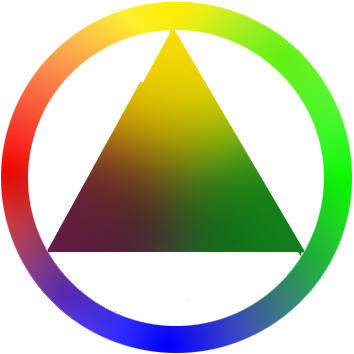
The triangle points at yellow, magenta and cyan. This is standard for printing.
But TV screens and monitors has red, green and blue dots.
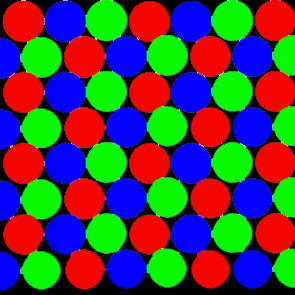
As mentioned you can fool your eyes to see yellow colours (lack of blue looks yellow). But the trick only works when you got 1000 dots in width. Some big commercial screens got fewer dots, and they need yellow dots too.
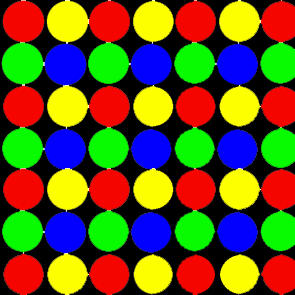
We have very hard to see a thin yellow line to a white background: that is why you do not have yellow white board pens. If you change to negative colours, it is hard to see a thin blue line to a black background.


If you mix yellow and blue you got green. If you mix red and black you got dark red. If you mix blue and black you got dark blue. If you mix yellow and black you got dark yellow. But you can not look up "dark yellow" in any dictionary. Yet there are dark yellow to choose from among colour palettes in the computers. Pictures are screen shots from Photoshop respective Excel (where dark yellow is called Olive Green).


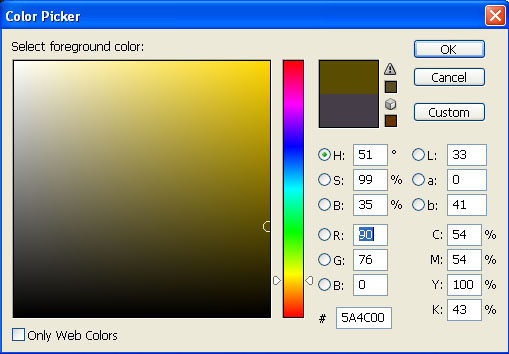
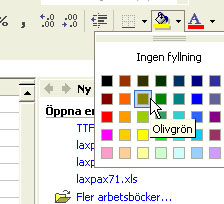
Eyes
In every living cell is a light-sensitive part. Rapid moving animals develop eyes, but slowly moving animals and animals living in darkness do not need eyes.
Octopuses embryos formed eyes from their skin. Fishes, birds, lizards and mammals (vertebrates) embryos forming their eyes from nerve endings (from the brain). Octopuses eyes and vertebrates eyes looks the same, with a lens and so on, but there are a big different between them. In octopuses eyes are the retina positioned in a correct way: oncoming light hit the retina. Behind the retina leads nerves to the brain. In the vertebrates eyes the light first pass through the retina and then hit the light sensitive nerves. Then the nerves go back to the front of the retina, collects in the middle, go though the retina again and then connect to the brain. This causes a big hole in the retina, calls the Blind Spot. Octopuses have no blind spot in their eyes. Normally we do not have any problem with the blind spot, since the brain are filling in missed information.
Cave paintings
What we see today of 10 000 years old cave paintings is the colours of white, black, yellow ochre and red ochre. But should not cavemen have used other colours as green and blue? Is it just that certain colours got pale after 10 000 years? Have scientist really not found any pigments from green and blue on that old paintings?
(I asked scientists) Link
Other colours, such as green and blue may have been originally present, but they could have dissipated. The dyes could have been oxidized by oxygen in the air and this would have bleached their colours. Green and blue shades can be made of copper-stone, but were difficult to work with. They did change colour after grinding and heating and were unstable over time. An artist avoided for these reasons copper pigments.
Back to my question: has anyone looked for copper remnants?
Gravity
Before scientists found the Higgs particle (above) they did not know if a particle that causes gravity or gravity is caused by something else. But they calculated that a "super symmetric partner" causes gravity.
Einstein could never solve what causes gravity. He was thinking of electromagnetic field, but what causes the gravity is something else. An electromagnetic field is light, radio waves, X-ray waves, heat, etc.
A material or body that accelerates, disturbes gravity. A planet in an orbit does not interfere gravity. A black hole distorts space-time and disrupt gravity. An exploding supernova disrupt gravity. Two massive stars (neutron stars) in a pair in an elliptical orbits, disrupt gravity.
The scientists are trying to detect such disturbance in gravity.
One example of a detector is one laser beam, reflected in mirrors. Changing the distance between the mirrors in the order of an atom, while filter our disturbances as traffic on a nearby road, small earth movements e t c, they are waiting for a detection.
Another detector is an aluminium rod, weight several tons, kept in few °K (in a giant thermos), hanging in wires. Any vibration, with the disturbances filtered out as mentioned above, indicates a gravity disturbance.
A third way to detect is to send a pair of satellites into space, measuring the distance between themselves by a laser. In a space no disturbances exists, except for gravity.
Electromagnetism
In the introduction I mentioned that "positive" and "negative" are only practical names in electronics measurings. But we can count of plus and minus just like a bank account.
We know that the compass needle pointing north. But it is the "north" end of a magnet pointing to north of the Earth. The Earth pole in the north has an "south" magnetic field.
But just as quarks are called red, green and blue, there really is nothing that is "negative" or "north".
When an electric voltage is in a conductor, a magnetic field arises. It is customary to identify the magnetic field with the "right-hand rule": we can imagine that you put your right hand on the conductor: the thumb pointing in the direction in which the current flows, while the fingers pointing in the direction of the magnetic field passes ("north").

If you move a conductor in a magnetic field, resulting is electricity and conversely.
In an electromagnetic wave (which includes everything from radio waves, microwaves in a microwave, infrared heat radiation, light, ultraviolet light, X-rays and gamma rays - the latter is the same as radioactivity), oscillates always magnetic field at 90 ° to the electric field.

AC versus DC
When the telegraph was invented, inventors stood facing the problem that there was resistance in the wires: a signal is weakened when it was sent over long distances. This was solved by connecting relays at regular intervals.
When Bell invented the telephone, he had the same problem : the signal was weakened when it was sent over long distances. Relays did not work on the phone signals in AC. Bell faced a problem: no amplifier was invented at the time.
Tesla had invented the transformer, but since he competed with Bell on electrical inventions, Bell could not condescend to go over to AC . Bell made it anyway, because it was pulsating DC as telephone signals: in this way he could amplify the signals.
Execution of people was made by AC: this made the rumours that AC was very dangerous. To proof that, they filmed when they killed an elephant with AC. But in fact; DC is more dangerous than AC.
Tesla solved the electrification of the railway in the United States. He realized that zero is practically dead using three phase, so you can use one thin wire and three thick wires instead of six coarse wires.
They tried to erase Tesla from the history books: in a dictionary from fifties or sixties you can not find him.
Velocity of current
What the frequency is, 50 or 60 Hz, is due to the length of lines in a country, least possible resistance in the wires.
The electrons runs with nearly the speed of light in the wires. Some of the electrons. Most electrons is stationary in the wires. In a AC wire alters a single electron back and forth.
DC runs in a circle in the wires. In the car a single electron runs from the battery, to a light bulb and back to the battery again. But is the same situation here: most of the electrons does not move. It takes average one or two days for a single electron to make one loop in the car.
Increases outlet in the wires, decreases the frequency: power generators may increase the effect. By some specific time, minutes, hours, days a s o, the number of produced Hz shall be within the specified tolerance. Large consumer areas are disconnected to prevent the frequency online runaway.
For a small generator makes it easy to connect into the network. When a light bulb, connected between the generator and main wires stop flashing, the frequency match. When connected to the main wires, you need to speed up the generator a little bit (Push the electrons). If not, you will have a big expensive fan at the yard instead of producing power.
Superconductor
There is normally some resistance in the wires: it is therefore a wire in a light bulb becomes so hot that it glows. However, it was found that certain alloys became unresisting at very low temperatures. Unfortunately disappeared resistance first at close to 0 ° K. When invented unresisting lines, you could enter as much effects, to yield superconducting magnets. When succeed they invented the levitating trains: the train was hovering above the rails. Unfortunately, you need to cool the wires and magnets with for example liquid helium or hydrogen, impractical for long lines, where liquid hydrogen is more easy to manufacture than liquid helium.
Attempts are to invent alloys that are superconducting at higher temperatures, preferably at room temperature. The record is 77 ° K.
Fusion
In the stars is a merging of atomic elements: this is called fusion. As more and more atoms are built up, energy releases: it is the nuclear reaction that creates the sun's heat.
Under high pressure are two protons compressed together. One proton is then converted into a neutron. If the nucleus captures an electron is converted to a hydrogen nucleus. If an additional proton is merging with hydrogen nucleus, it is forming deuterium. Two merging deuterium atoms forming helium. Two helium atoms can join together to form Beryllium. The Beryllium atom may merge with a helium atom and form a carbon. The carbon atom has six protons and six neutrons. Some larger atom than carbon is not normally created in the stars fusion.
When the nuclear fuel in the star begins to run out, nucleus as oxygen, neon, magnesium, silicon, sulphur and iron are created.
When more nuclear fuel has burned out, the star explodes as a supernova: the nucleus heavier than iron are created. Link
It takes a million years for the heat (particles at high speed) to go from the solar centre to the solar surface. Collidings made the particles go in random direction.
Fission
Mentioned above all particles heavier than lid will sooner or later be lid.
Radioactivity occurs naturally in the earth's interior. Then Kelvin defined thermodynamics, he estimated the age of the Earth to be 20 million years old. He did not know the radioactivity, delays the cooling down of the earth. It is believed now that the earth is 4.5 billion years old.
Since the discovery of the neutron in 1932, began Enrico Fermi irradiate heavy nuclei with neutrons, in order to create even heavier elements. Instead of heavier elements was formed lighter elements. Lise Meitner and Otto R. Frisch wrote an article that explained the phenomenon in 1939, which they termed the "fission", which means cell division.
If you had installed a nuclear plant in your house, it would suffice with one rod of uranium per year, the size of a pencil, cost a couple hundreds dollars, to heat the villa. On meter thick concrete will prevent the radiation from leaking. But no one will take that risks today. But late 50´s they were thinking of nuclear driven cars Link. Last nuclear driven satellite was sent up 1988 Link
An atomic bomb works in the way that uranium is added as a shell inside a steel capsule. The radioactive material is then too loose to a chain reaction can start by itself. When detonate the bomb, you start a chemical explosion, which compresses the radioactive material: a chain reaction occurs. To an uranium bomb you need material to 18 centimetres in diameter or 53 kg. For a hydrogen bomb is enough hydrogen, size of a football. The hydrogen must be ignited with a small uranium bomb. Link
In a basement in Chicago University stacked Enrico Fermi graphite plates with holes. The holes were transferred rods of uranium and cadmium into. Cadmium rods were here moderator rods. One after another was pulled cadmium rods out. If the calculations were correct, would a self-sustaining nuclear fission come in time: if the calculations were wrong, would either no nuclear fission getting started, or a meltdown occur. But the calculations were correct: a self-sustaining nuclear fission started. After 28 minutes, they pushed into the moderator rods. Link
Waste from nuclear power plants
There are a lots of nuclear power plants in the world. They have so far produced thousands tonnes of radioactive waste. Link
In a Uranium rod is 99% U238, a stable isotope. The remaining percentage is made up of Plutonium, Americium and Curium, where Americium is radioactive for 100 000 years. One can distinguish three different radioactive subjects from a depleted uranium rod.
You can make new fuel rods of Americium and place them in special nuclear plants. The waste is then radioactive in only 1000 years. Americium is a poor conductor of heat, so rods only with Americium will melt. Americium is so high radioactive, so in a laboratory the can normally only handle 0.1 grams; in a special laboratory 150 grams. Link
Plutonium has a half-life of 24,600 years, and Curium 17,000 years.
The half-life may be shortened if you cool down the waste to 10 ° K. Plutonium 210 has a half-life of 138 days. By cooling Plutonium to 10 ° K, the half-life will be only seven days.
Fusion reactors
The fuel in a fusion reactor consists of heavy (deuterium) and super heavy hydrogen (tritium), available or can be prepared in virtually unlimited amounts . From one litre of seawater you can get fuel to provide energy equivalent to 300 litres of oil. The fuel must be heated to 100 million degrees, before it becomes a plasma, in which the nuclei can fuse together. As son this happens, the electrons are removing from the atoms. The atoms then become positive and repel each other. They need to be compressed with magnetic rings to keep the fusion ongoing. Also this plasma need to be in vacuum. If the plasma touches the reactor wall, it cooled it off, while the wall melts. Mainly deuterium used as fuel, but tritium must start the process. More tritium is produced subsequently in the process. A heat exchanger provides a turbine with steam, which in turn drives a generator, just as in a fission.
Cold fusion
Will be back as soon as something interesting things happens.
Light
The size of an atom is about 10-7 mm, i.e. 0.0000001 mm, while the wavelength of the light is about 0.0005 mm. It means that the wavelength of light is 5000 times greater than the atom. If an atom were as large as the earth, the light in the same scale only contain two waves on the distance between the sun and the earth.
In the 1600s, Isaac Newton came to the conclusion that light is a stream of tiny particles that we now call photons. Link
In the 1800s, however, did Thomas Young trial that proved that light must be waves. Link
Young made an attempt to send a beam of light through two narrow parallel columns. The light was captured on a wall. Instead of the formation of two stripes on the wall, after the expectation was formed several stripes. The explanation was that light behaved as waves, which caused interference pattern.
In the early 1900s Einstein theorized that light is rightly spreads like waves, but as soon as it interacts with matter, it should be seen as a stream of photons.
If you dim the light (lower the light) the interference patterns disappear. Instead you see single photons. The light beam could not be less than a quanta.

Laser
Light from a light source oscillates at all possible wavelengths in all directions with all possible orientations of the directions of the waves. The waves are not polarized.
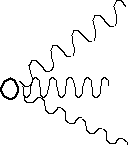
Light between two parallel mirrors, creates substantially parallel light beams.

One of the mirrors are some transparent to allow some light passing out of the system.
If a suitable material is placed between these mirrors, and pumping energy into the material, the material will send out one type of a wavelength.
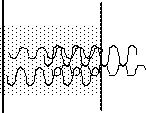
The light beam can never be absolutely parallel, since mirrors are never going to make absolutely parallel. So the laser beam spreads. A laser pulse from earth to the moon spreads a few centimetres.
The energy pumping up the laser is done by light. The electrons are pumped up to an excited state with energy, next bigger possible orbit around the atom. Pumping can be done with a camera flash (a pulse) or by bright continuous light (continuously laser beam.
If a suitable material is inserted between the mirrors, electrons sending only one kind of wavelength. The material may be argon, krypton or ruby.
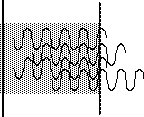
The waves are also in the same phase and polarized.
Also the distance between the mirrors need to match the wavelength.
By this type of laser you can measure distance, heat material, do welding and make holograms.
Diode laser
A diode laser is cheaper than previous, but also lower intense. The beam is not so concentrated. Electrons are pumped up by electrical power. Diode lasers are used for lights and CD writing and reading.
CD and DVD
An arm with a diode laser looks for information track in a CD or DVD. When the laser finds information, it keeps the track on radial distance on the record. It keeps also the distance from the disk surface by keeping the laser beam in focus. Different in heights in the groove by a half of a wave length gives different signals, 0 or 1. That is why you can have two tracks on a side, where the deep of the two tracks are different. By having two tracks on both side of the disc, you will have four tracks. And blue laser is smaller than a red and give room for more information.
When recording a CD or DVD, some information in the silver or gold layer are oxidised and jumps into the adjacent plastic layer.
But I have to say: CD and DVD does not last forever. When copy a VHS to another VHS you always got a copy, but with not so good quality. But when copy a CD and DVD to another, you got a perfect copy, just as the manufactures say (if you are lucky): but one scratch or dust will also be copied. So also here you may have a not so good copy.
I also have to say: I have hundreds of rewritable DVDs: when trying to look at 5 yeas old recordings, about 1% are no longer possible to play. Information vanished. Nothing like that happens with my old VHS tapes.
X-RAYS
X-rays go through the most material: only
thick lead sheets or concrete walls prevent waves. This means that it is
difficult to focus the rays. But satellites must be able to focus the rays. This
can not be done with a mirror: X-rays go through the mirror.
There is no material which reflects an X-ray as a mirror. However, a metal
surface can reflect an X-ray beam, if the beam comes in a very small angle. By
combining multiple cone-shaped tubes, it is possible to focus the X-rays.
![]()

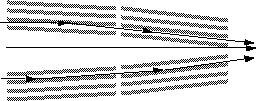
Milky Way and other galaxies
Our galaxy is called the Milky Way. It's discus shaped, where most of the stars are gathered in the disc, or a battered disc. We are in the disc, between the centre and the edge. We can see the stars in a string around us: that is the Milky Way. Our galaxy has a more complex structure than a flat discus. It is thicker in the middle, where the stars are gathered in one big ball. Inside the centre is a black hole. The disc is divided into four (or five) spiral arms. The sun is located in the "Orion Arm ". The arms are not in the spiral straight into the centre of the galaxy: close to the centre the arms is a rod.
A galaxy' development starts off as a cluster. The gravitationally movements of the stars are collecting the stars in a disc and in arms. The arms have a greater density of stars, shining dust and young stars hotter than the galaxy as a whole.
Each galaxy usually have the company of smaller star clusters. It seems that the gravitational disturbances from star clusters affect the formation of the arms of the main galaxy. Around the Milky Way are a hundred star clusters. They are spherically spaced around the Milky Way. The two most famous star clusters are the Magellanic clouds.
Thomas Wright in 1711 presumed there should be other galaxies. In 1920 they could prove it. The astronomer Edwin Hubble who discovered it: stars were similar but much fainter: they should then be located far outside the Milky Way. The milky Way is 100.000 light years, but the distance to the Andromeda galaxy, our nearest neighbouring galaxy, has a distance of 2.2 million light years.
Edwin Hubble found a way to measure distances in the universe. A pulsating star, Cepheid, are unstable and pulsate in brightness: where the pulse speed match the brightness. This is a rough measure of the distance to the galaxy.
All galaxies are gathered in clusters, separated with dark matter. The structure is like a sponge. Link
Expansion of the universe
All hot material emits a spectrum. Each kind of atom creates a "fingerprint" in the spectrum. By analyzing the spectrum of a star, one can deduce what kind of matter the star contains (on the surface).
![]()
When astronomers began to study nearby stars, they using a prism to create a spectrum, But sometimes they found the spectrum moved a little bit to the blue, sometimes to the red. They were first thinking of strange matters. Conclusion was that when shifting to blue, the stars were approaching us; when shifting to red the stars were distancing from us.
![]()
![]()
It was discovered, that the more distant an object is, the stronger red shift causes it. So even the size of the redshift giving a rough measure of the distance.
This gave the theory that the universe is expanding.
Some items has so large redshift that are normally invisible parts of the spectrum becoming visible.
![]()
As the universe expands, should the entire universe once have started from a small point: the power that made the universe to expand at one time called the "Big Bang".
Counting backwards of the expansion, scientist are coming to the conclusion that the universe may be about 15 billion years old. Today scientist the universe is 13.7 or 13.8 billion years old, but it is hard to calculate. The redshift gives a value between 10 and 20 billion years, The half-life of radioactive isotopes gives a value of 12.5 billion years old.
At the Big Bang no common particles exists, because the universe was too hot. Today it has cooled down to appr 4 ° K, shown by the famous picture of the universe.

At the Big Bang no light exist. The further out you are looking, the older stars exist. At a very big distance the stars have not lit yet. If the stars was not old further away we should see a star in any direction, in any magnification, just like trees in the wood. But we do not see stars like this.
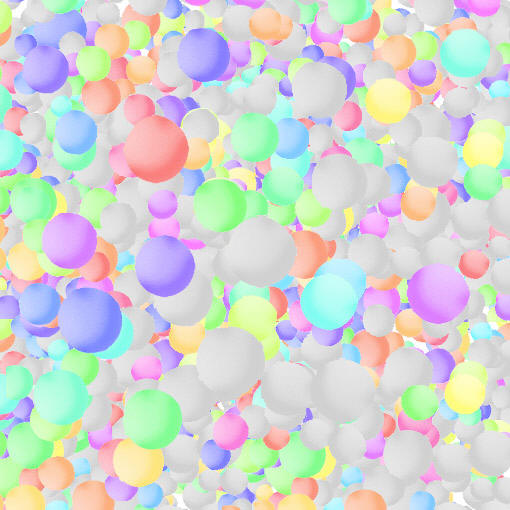
At the distance of 13,7 billion light years, nothing is possible to see of the universe. We have a dark wall, calling the horizon.
The oldest object found is 500 million years older than the Big Bang. And as above, the further out, the older and stranger objects we found (galaxies are in random shaped clusters).
So something causes the Universe to expand. The scientists called it Dark Energy. That keeps the expansion to accelerate. Link
The constants in the universe are just fitting
N is a constant, the difference between the strong forces that hold the atoms together and the gravitational force, 1035. If N were smaller, there would only be a miniature universe. Top-standing creatures would be insects: there would not be time left to create superior beings.
E has a value of 0.007. It determines how strongly the nuclei bonded to each other, the Earth's formation and the energy conversion of the suns. If E was 0,006 or 0,008, we would not exist.
W is the amount of matter in the universe. W is the difference between gravity and expansion energy in the universe. If the value was larger, the universe would collapse; if the value were less no stars or galaxies would have formed.
l (lambda) is the force that accelerates the expansion of the universe. The force is small, otherwise the universe would not have formed.
Q is the energy that exist before the Big Bang. If Q was smaller universe would be dead and structureless. If it was bigger it would be a violent world, consisting of black holes.
D is three, as in three dimensions. Life would not exist if D were two or four.
More examination of the spectrum
Each electron has its definite three dimensional orbit around the atomic nucleus. Adding an electron energy, any microwave in the form of a photon or heat, electron can jump to a higher orbit, an excited state. When the electron later jumps down to a lower energy state, emitted a quantum, a photon. The wire in the light bulb and iron in the furnace glows because it is hot: when electrons jump down into the lower orbit, courses emitted quanta, including in the form of visible light.
Conversely, a cold gas absorbing certain wavelengths of the light coming through it: if there exixts any excited electrons in the gas.
![]()
Hydrogen has eight different energy levels as the single electron can jump between.
The length of the electron's orbit must be a multiple of the wavelength of a particular light. That is why the electrons jumps down or up into different tracks: the length of each orbital revolutions must comply with a wavelength, a quanta.
More changes of the spectra
Besides the red and blue shift mentioned above, changes occur in the spectra of other causes. First I show a normal spectrum.
![]()
If a star has a high rotational speed, there are also red-and blueshift in the spectra.
![]()
If there is high pressure in the star, only certain spectral lines are broadened.
![]()
If a star has a strong magnetic field, some spectral lines are split in half. The stronger the magnetic field, the greater the number of lines in the spectrum will be split in half.
![]()
Reference: The Swedish scintist magazine Illustrerad Vetenskap 5/99
Conclusions
If the atoms are exposed to high pressure, the orbit of the electrons and emitted light be affected.
A strong magnetic field can affect the spectrum, because photons are electromagnetic waves. Note that some colors of the spectrum changes in defined steps.
Colours of the stars
One reason that we do not see green stars, is not the lack of the color of the objects, but to our eyes it difficult to perceive faint green light, among other weak colours.
A star over-exposed on a photo: this is why it is white. The astronomers found out that if you take multiple exposures on the same image, with the sharpness set different and with the telescope slightly offset between each exposure, appears the actual colours of the stars anywhere on the photo.

A tribute to David Malin. He exposed three different glass plates in three different nights, using the colour green, red and blue. Link Link
A flat universe
Scientists suspected that other natural laws would apply in the universe, example that the sum of the angles of a triangle is not always always 180 °. However, it was found that the same natural laws that apply there as here, and called it "a flat universe." The universe is not flat, it is 3D, but here "flat" is the geometry.
The sum of the angles of a triangle is always 180 °, provided you have a flat object. But if you have a triangle on the earth, with one point on the north pole and two points on the equator: the triangle's angles may well be 270 °.
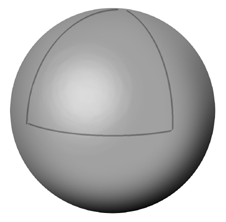
And if you draw a triangle on a saddle, a ring or a trumpet, the angles are always <180 °.
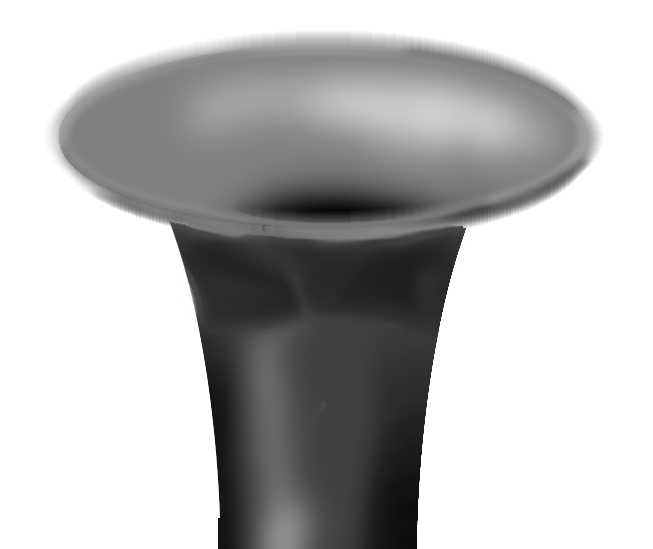
New addition of matter
In the vacuum in the universe high energies spontaneous create a pair of particles, for example an electron and a positron. And if they are separated new particles are created.
The future of the universe
The universe will continue to expand indefinitely. All matter will end up as black holes. The universe will be dark. The particles will dissolve.
The number of grains of sand on all the beaches estimated to be 1023. The number of stars in the visible universe is estimated to be 1022. The number of atoms in the entire visible universe estimated to be 1078. The universe will exist in 10100 years.
Telescopes
When invented big telescopes astronomers discovered that the Earth's atmosphere is uneasy and distort images. Also, a big telescope with a lense will be bend as a banana. A big telescope with a heavy mirror located in the bottom will also be bend.
That was why they invent the Hubble telescope. Link
The mirror manufacturer to the Hubble Space Telescope adjusts the big mirror like this: they grinded the mirror one day and then transported it into a test chamber and let it adjust to room temperature for one day. Thereafter measured the wrong manufacturing on the mirror using a laser: the beam would be reflected to a certain calculated point. When showing inaccuracies, they transported the mirror into the room for regrinding adjustment. That was repeated until no inaccuracies were found. But when send the telescope into space they found the pictures not better than earth based telescopes. The Hubble telescope was wrong made. The measuring equipment on the factory was painted black to not affect the measurement result: any extraneous light would interfere with the detector. But a small paint chip was missing on the detector: it was at the hole for a screw. The damage was too small to be discovered. The inaccuracy was corrected with a lens in the telescope.
After that we know hot to build bigger telescopes on Earth. The heavy mirror can be supported with moving supports
And we know how to adjust small mirrors, to compensate for the troubled atmospheric distortion. Some telescope corrects up to 1000 times per second.
We also know how to optically connect two nearby telescopes: the diameter of the telescope then becomes the same as the mirrors total area.
Star formations and planet formations
After the Big Bang the Universe consisted of hydrogen and helium. Variations of gravity formed the gases to galaxies and stars. In the stars a nuclear reaction started. When the stars used most of its hydrogen and helium, it becomes unstable and explodes as a supernova, with heavier atoms than iron are created. These first stars are named Population I. After the supernova explosions the matter can create planets. New stars may be created by a mixture of hydrogen, helium and heavier atoms: those are named Population II.
Giant planet may have sufficient attraction to retain a light atmosphere of methane and ammonia, while small planets looses some or all atmosphere.
Gravity between planes effects distributions of planets in orbits. The difference between the orbits are fairly even numbers, fractions. With a computer program you can draw beautiful patterns, in the form of flowers. Either nail the sun in the middle, or any planet, and different patterns will appear. Link
When the planets was created in our solar system, it was hundreds of small planets. Gravity merged the small planets to bigger ones. When two big planets collides, the either merged or created small fragments.
The asteroids between Mars and Jupiter may either be small fragments, never merged to a big planet, or remnants from a big collision. Link
When our eight planets was created, Jupiter and Saturn were much closer to the sun than now, pushing Mercury, Venus, Earth and Mars even closer to the sun. Ref.: The Swedish science programme Axess, November 2013.
Exo planets
When start looking for planets outside our solar system, the first one was found 1994. The first one found were big, like Jupiter. The system to find the were to find if a planet in orbit was gravitationally periodically rocking the star (top picture) or periodically hide the star a little bit (bottom picture).
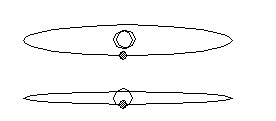
Jupiter causes the sun to rock 12 meters/second. Exoplanets were found rocking the star less than this or dimming the star as little as 1,8%. Reference.: The Swedish scientific magazine Illustrerad Vetenskap 4/2000.
A calculation indicates that 10% of all stars has planets. This gives that it will be 30 billions planets like the Earth in the Milky Way. Reference.: The Newspaper Sydsvenskan July 3 2002.
Pre-shaped planets are named proplydes. Link
Astronomers
found a planet
only
13 billion years
old, 0.7 billion years
older than
the universe.
The planet has
30
times smaller composition of
heavy elements compared
with our sun.
Reference.: Illustrerad Vetenskap 1/2004.
Astronomer also found in the stellar constellation Orion 18 planets without any
star. Reference.: Ny Teknik 40/2000.
The last three sentences means that the
theory of how planets are shaped does not match.
The smallest star
that can be
made
has
1/10 the mass of the Sun,
else
fusion
does not start.
The biggest star
that may exist consist of
150
solar masses
Reference.: The Swedish scientific magazine Forskning & Framsteg 9/2012.
If the fusion does not start, the object will have a fade glow: it is called a brown dwarf. Link
The Moon and the Earth
A planet, smaller than the Earth, collided with the Earth. Materials from the earth banged up and formed the moon. The moon is made of the same material as the Earth's crust.
The moon was once molten in an orbit near Earth, caused the moon to be egg-shaped and always turns the same side towards the Earth.
High and low tides on Earth slows down the moon in orbit. The moon goes further from us with 4.5 cm per year . The tide slows even up the Earth's rotation by 0.02 seconds per century. When life started at Erath the days were only 14 hours long. Historical events 2000 years ago with solar and lunar eclipses, need to be adjusted with three hours.
The sun heats the air, starting winds to blow. Bad storms may pushes to the mountains, effects the Earths rotation to move as much as eight meters.
When Alfred Wegener in 1915 mentioned his theory of continental drift, no one believed him, but it was confirmed 1965. India slips under China with 6 cm per year, Himalayas rises by 10 - 15 mm per year, Island being split at a speed of 2.5 cm per year, Hawaiian Islands moving at a speed of 6 cm per year, Africa is splitting too and lifted up by 500 meters. Magma from the deep moving the continents. It takes the magma 4 million years to rotate one revolution. Link
Each year the Earth's weight increases by 40 000 tonnes because of all the meteors. It takes 250 million years for the earth to grow 1 mm.
The Earth's atmosphere contains 21% oxygen and 78% nitrogen. If the oxygen level rises to 25%, all existing vegetation to burn up. Trained climbers can cope with 7% oxygen.
Constantly 1800 thunderstorms are going on on Earth. Lightning strikes down 100 times every second. Every year 1,000 people die from lightning.
No one really knows what Ball lightning are. A ball lightning sends out very little heat, but can cause burns if you hit by it. Link
Our solar system
Our four giant planets have rings, but they are shaped by a variety of reasons, from a moon grinded down by the planet's gravitation to a comet is captured.
The asteroid Ida has a moon with a diameter of 1 kilometre.
Asteroids are minor planets in more circular orbits around the sun.
Comets have more elongated orbits. They consist of rocks, but also lots of ice. When the comet approaches the sun, the ice vaporize: the formation of a tail that is always in direction from the sun, due to solar wind.
The gravity on Earth is 10 km/s, but on a comet maybe 1 m/h. An astronaut can jump from a comet and never coming back. On a small comet the force of the rotation may be bigger than the gravity. Link Link
If not Jupiter had absorbed so many asteroids as happens, the Earth would hit but thousand times so many meteorites as it does, where life never would have time to start.
The area outside Pluto is called the Kupier Belt. This is as far as our telescopes may detect minor planets. Link
Outside from that is the Oort halo. As many as six trillion small planets may have a distance of 20,000 times the Earth's distance from the sun. Sometimes a start may touch the halo, end when it happened maybe a new comet are created. Link Link
Every year 80 meteorites hit the Earth.
Development of galaxies
When the stars contracts to a galax, it is a cluster from the beginning. The cluster starts to rotate. Gravity shapes the orbits to be elliptical. Different speeds of the orbits cause the ellipses axes to turn. A disc with spiral arms are shaped, same shape as the Milky Way.
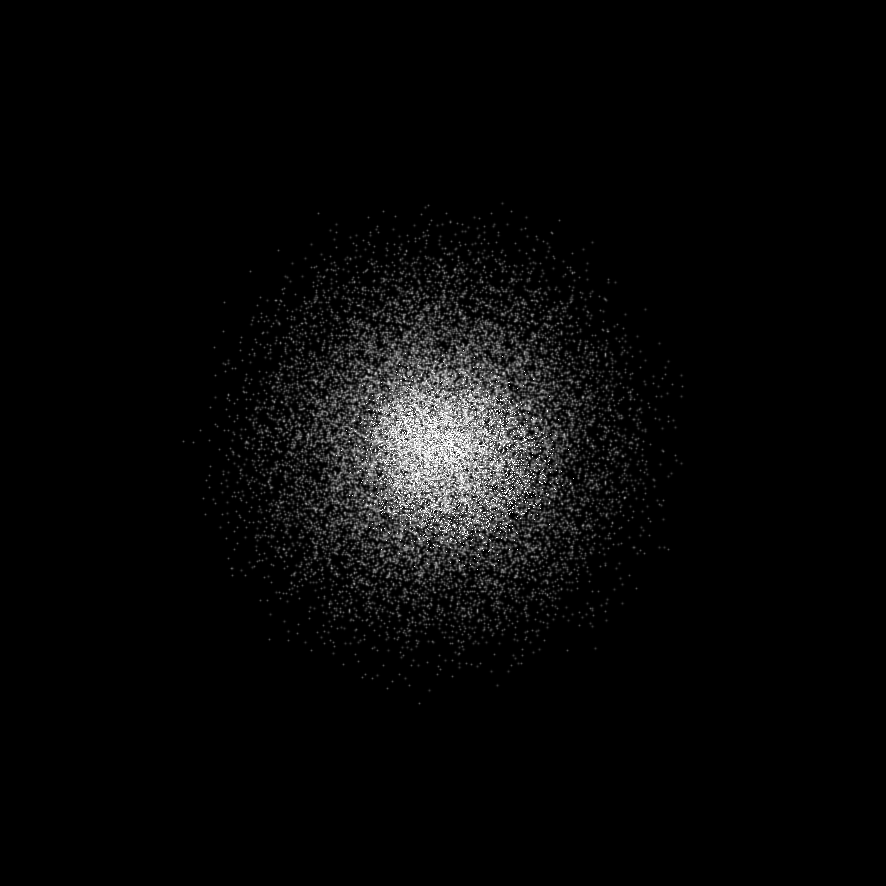

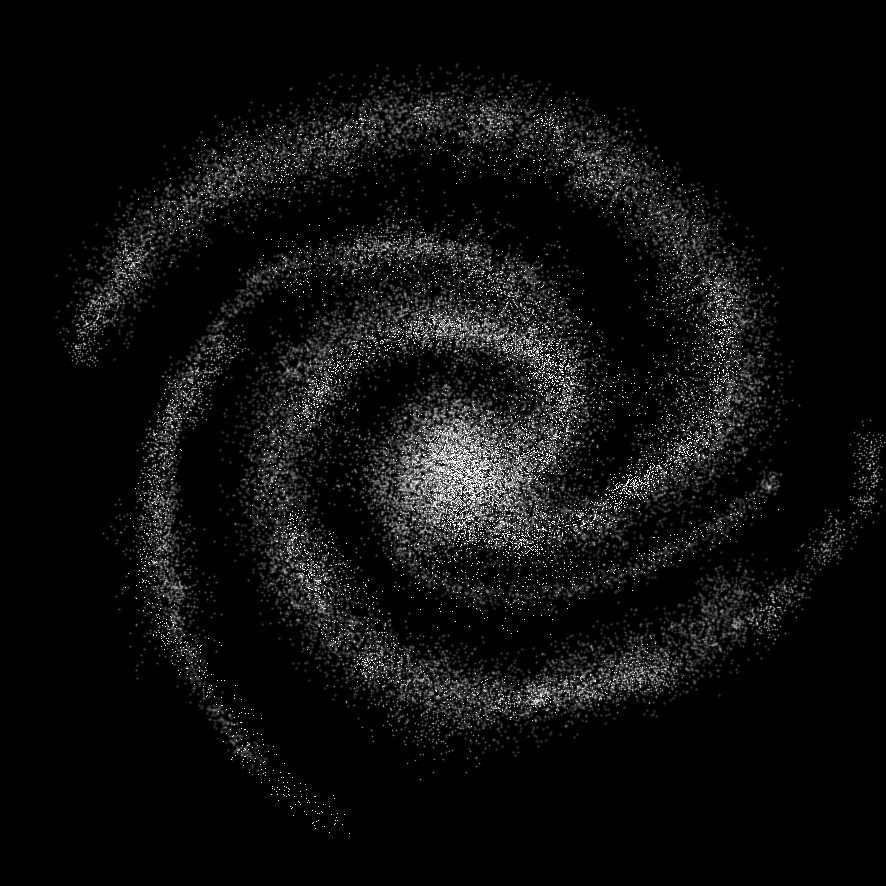
Then the ellipses axes are aligned by gravitation. When the galaxy is older, does gravitational disruption to the elliptical axes are collected in one direction. The galaxy looks as if a rod goes through its centre. The galaxy called a barred spiral. Link. Reference: The Swedish Scientific magazine Illustrerad Vetenskap 7/2006.

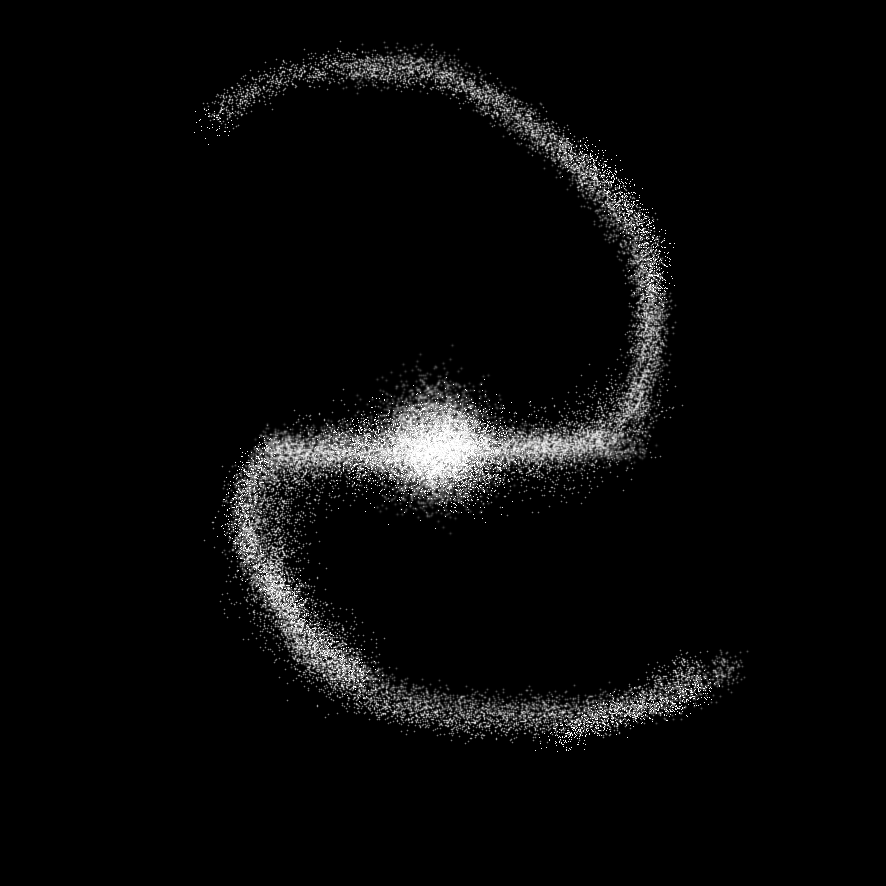
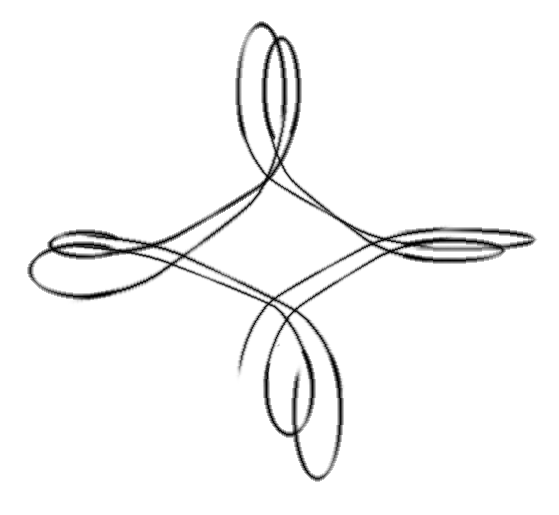
In the middle of a barred spiral the stars moves in very complicated paths, where they may leave the galaxy (picture top right). Reference: The Swedish Scientific magazine Forskning & Framsteg 3/2000.
Very distant galaxies are blue and irregular, where blue indicates new born stars.
Astronomers estimates the number of galaxies in the universe at about 50 billions.
Collisions between galaxies
Galaxies often collides. It does not mean that the stars collides. There are four types of collisions: Two disk-shaped galaxies collides with opposite rotation directions, edge to edge; same but the flat side against the flat side, opposite or same rotation direction; respectively a cluster or small galaxy goes through a big disc-shaped galaxy.


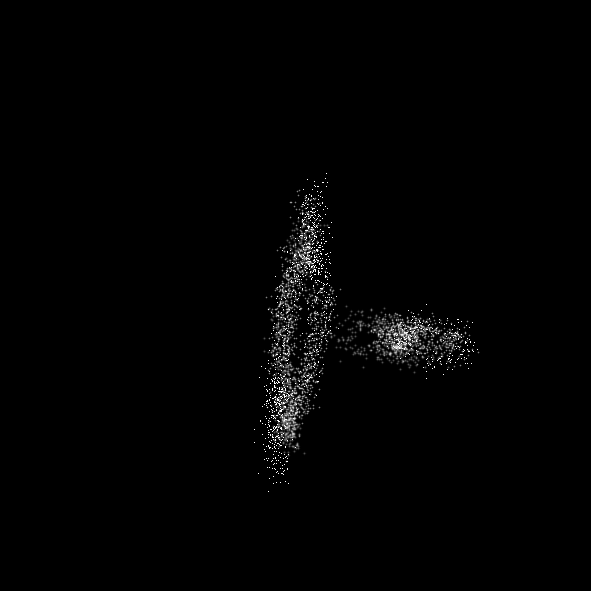
The first type of collision spreads the stars into space; the other types merge the stars.
The Milky Way will collide with the Andromeda galaxy in three billion years.
Typically, a large galaxy are surrounded by several dwarf galaxies, and devour them afterwards. It is believed that Milky consumed between 5 and 50 dwarf galaxies.
Half of all galaxies have devoured or collided with another galaxy. Reference: Popular astronomy 1/2006.
If a collision occurs between galaxies, it will cause the creation of new stars. If a galaxy never collide with another, the galaxy will die. Reference: Forskning & Framsteg 3/2000.
The weight of light
Einstein found out that the light has weight. At an eclipse it was confirmed: the stars behind the sun changed position a little.
The sun beam going to Earth change direction of a diameter of an atom. It is close to a straight direction, but it is not.
A galaxy has more mass than the sun and changes positions of another galaxies behind even more.
It is called Gravitational Lenses. Link
By gravitational lenses we can see the affect of strange matter and black holes, but we can never see the objects itself.
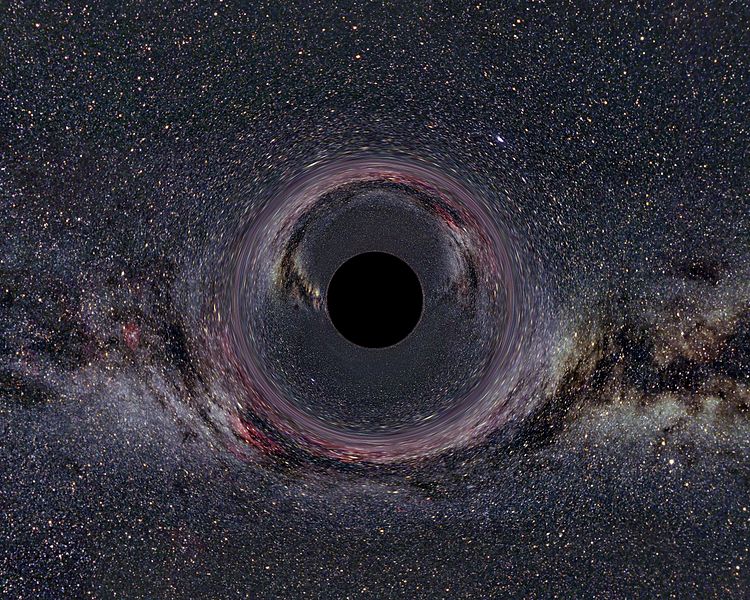
Black holes
A black hole has so much gravity, that the light can not escape from it. Link
In every galaxy is a black hole. The gravity from the black hole starts the creation of stars. The mass of a black hole is 0,5 % of the galaxy.
If the light from a black hole just may escape to its surface, but no more, it is called a grey hole.
Even coloured black holes may exist, since gas being suction in to the black hole, where radiation may give a colour.
Multiverses
The theory of parallel universe with a little different of gravity forces, radiation, expansion speed of universe and so on. Link
Several universes will explain why "The constants in the universe are just fitting" (above), where each universe tries combinations of constants for best survival, just like a plant.
Centrifugal force and gravitation
The Earth bulges at the equator because it rotates. How do the earth know it rotates? We can look at the stars, but do we know the heaven rotates or the Earth rotates?
Einstein found that space-time is curved by a massive body: this curvature accompanies the earth in its orbit. This is a braking effect, like a tide, called frame - dragging . Link
In next example you are standing at the North Pole. In front of you is a weight hanging in a several meters long cord, a pendulum. You step back a few meters with the weight, let it stabilize and then release. Reasonably the pendulum should follow the Earths rotation, but it is not: the pendulum is oriented to a fix direction in space.
At the equator no such affect happens.
But when Foucault demonstrated such a pendulum in Paris, the pendulum was back in start orientation after 32.7 hours. Link
Phenomena at high speeds and the speed of light
The light is 300 000 km / s in a vacuum. In hard materials is light travels slowly: in glass, it is 175 000 km / s and in diamond 124 000 km / s.
In water light goes with 225 000 km / s. Particles can, however, go near the speed of light in water: that's why the water glows blue in the cooling basin around the reactor.
Remember: there is a difference between a particle's speed and the speed of light.
The light is the same as an electromagnetic wave, means that the radio waves always go the same speed as light.
The speed of light (the constant) may differ from the Big Bang to now. Probably not, but if it alter, all constants alter too. See section "The constants in the universe are just fitting" above.
A light year is the distance that light travels in a year. A light year is 9 500 000 000 000 km.
It is eight light minutes from the sun.
It is 1.3 light seconds to the moon. Before we had communication satellites, scientist tried to reflect telephone signals to the moon. It took the signal three seconds before it reached the receiver, where the conversations became confused. Please look at the programs when man was on the moon.
Normally we do not think that the light must be given time to travel a certain distance: when we switch off the light in a room, the area closest to the lamp gets dark first.
The most distant objects in Universe takes almost 14 billion years to reach us.
Objects become heavy at high speed
Einstein's theory of relativity says that nothing can travel faster than the speed of light: every object becomes infinitely heavy at the speed of light: it then goes to infinite energy to accelerate an object.
Astronomers had noticed that the planet Mercury does not go quite regularly in the orbit. Einstein's theory of relativity explained the phenomenon. The planet is so quick around the sun, that the mass increases slightly. The increase is extremely small, but not negligible. Because Mercury is in an elliptical orbit, it means that it is sometimes heavier. This means in turn that the axis of the ellipse rotates. Link
Note: even Venus, Earth and Mars change in position a little bit of same reason, but the effect are not noticeable for planets outside Mars.
The affect are also noticeable for satellites: Lageos 1, and Lageos 2 changing in positions 2 meters per year.
If an object is running at half the speed of light the mass increases by 5%. If an object is at 70% the speed of light, its mass increases by 25%. If an object goes with 90% of light speed the mass doubles.
But some particles without mass may travel faster than the speed of light.
Tachyons are theoretical particles that may travel faster than the speed of light. Link
The speed of light varies
The speed of light varies: it is an average speed. In a trap slow light beams will be stopped, but fast light beams go through. Link.
The Danish physicist Lene Hau first slowed down the speed of light to 17 m/s, then to 0. Link
There are also a theory of that the speed of light was different just after Big Bang. If this is correct, it means that the speed of light still changing, and all the constants (above) changing too: that is why all the constans just fitting today.
Aging are different at high speeds
If you send up two clocks in two different spaceships, and one travelling westward around the earth, the other one eastward, the clock, travelling westward goes faster. Reference.: Stephen Hawkins.
GPS
On a flat surface three GPS satellites will give you your coordinates within 10 cm. A good calculator will give the result within 1 cm. But to give your height coordinates you must be connected to four GPS satellites, the height position with a little coarse tolerances.
But the Earth is not flat, it is a sphere with a little combination of a pear and a pumpkin. Also gravitationally effects from mountains and iron minings will change the orbits of the satellites. And the satellites positioning adding a difference with 2 cm per year because of effects mentioned above.
Reference: Hans-Uno Bengtsson, Lund University
Gyroscope
Compasses are impossible to use in submarines, because the ship is magnetic. Nor is it possible to use compasses near the poles, because the compass needle will point to the centre of the Earth. The solution of navigation is to use a gyro. But affects mentioned above, make the gyros alter a little bit: for every revolution around the earth the gyros alters 6.6 arc seconds. To this, 0.042 arc seconds due to frame dragging.
Reference: Hans-Uno Bengtsson, Lund University
Space flights
I remember when Sputnik I was launched into space. It was 1957. I was 7 years old then. I visited my uncle. There was very low light in the house: uncle's family sat staring at the radio. We, visitor, got to keep us quiet. I could not understand the reason for being so upset then, but later realized how sensational it was.
The Russians were first in space with Sputnik I. It did only sending radio signals, to tell everybody it existed.
The Russians then sent dogs into space. It was also in 1957.
The Americans send monkeys into space in 1959.
The same year sent the Russians three satellites to the Moon: Luna 1 passed the Moon, Luna 2 crashed as the first satellite on the moon and Luna 3 took the first pictures of the moon's far side. Not until the first crash we could only estimate the gravity of the moon and if it was possible to walk on the moon.
Yuri Gagarin was the first man in space, in 1961. He was Russian.
That same year was the first American in space: it was Alan Shephard.
In 1962 was John Glenn in space. Many people have the idea that he was the first American into space, and scientific American TV programmes still got same odd idea too. But John Glenn became the most famous one.
In 1969 the American put their feet on the moon.
Space flight became common: Apollo 13s journey in 1970, was not even send on newscasts, not until there was an explosion in a hydrogen tank and crew risked dying in space. Apollo 13´s crew still has the record of being most far from Earth: they did not slow down when passing the moon; instead the passed the moon in a big loop. Link
Interesting to know: it takes two days to travel to the moon in a spaceship, but nine months with the speed of a car.
Most rockets start at the equator and heading east, due to the earth's rotation (they got the most speed already at start).
More space travellers
The first private space traveller was Dennis Tito, who paid $ 20 million to get into space. The other was Mark Shuttleworth.
China's first spaceman was Yang Liwei October 15th 2003.
The world's first female space tourist Anousheh Ansari was September 19 2006. It was told she been paid 180 million dollars for the adventure.
Oldest man in space is John Glenn, 77 years old.
Link
The first private manned space flight occurred on June 22
2005. Michael Melvill
flew Spaceship. Link
Phenomena in weightless state
An astronaut will be about 4 cm longer in a state of weightlessness: The spine becomes prolonged.
Blood is not pushed down to the feet by gravity. Blood is not supposed to rush into the head either: solution is that the stomach swells by blood. This may change the medication: aspirin to head ache works faster than normal, while compounds to be broken down by the liver and kidneys works slower. Faces are changing in weightlessness.
The amount of blood in the body reduces: the heart becomes weaker.
Astronauts does not use their feet: they are moving by using their arms. Leg muscles reduces. The bones became weaker. They got baby soft heels. Two hours physical exercise per day is not enough.
When astronauts return to Earth, their head feels heavy, like a watermelon.
A fire in weightlessness is virtually hardly undetectable: the flame is spherical with a perfect combustion, almost colourless.
Trip to Mars
Mars is the only suitable planet there is to go to. The trip to Mars takes about 8 months. Including staying and the trip back will take two years. And the trip is possible only every other year. It takes at least seven minutes for a radio signal to pass between Earth and Mars. It is so popular to travel to Mars and make the planet habitable, so a mars flag exist.
Casimir effect
If you have two metal plates, very narrow but still some space between, you got more photons outside the plates than between them: the photons will push the plates together. Link
String theory
The theory of a vibrating string will create any particle, depending of how it vibrates. This theory will also solve the extra dimensions the scientist needs.
Brane (membrane) is how many dimensions there is. A point has brane 0, while a string has brane 1. In link above.
Antimatter in the Universe
Above was described how in laboratories create antihydrogen: one particle per one anti particle. So it shall exist as many galaxies of anti matter as galaxies of normal matter. But it is not so: most of the visible universe consist of normal matter.
Antimatter sends light as normal, but was detected by it polarize some chemical compounds different than normal matter.
Dark matter
The known universe contains 4.9% ordinary matter, 26.8% dark matter and 68.3% dark energy. Dark matter was found as gravitational lenses. Dark matter sends no light at all, and does not effect light either, except for gravitas effects.
List of unsolved problems in physics
Controversial phenomenon's
I will separate facts from myths and what we want and believe to see.
Astrology, seers, miracles, auras
We see forward anyone winning the James Randi one million dollar price. Link
Nostradamus is famous. But none of his predictions have come true. It is conclusions afterwards. A seer is supposed to foretell in advance. Link

Kirlianphoto. Link
UFO, alien
Nothing much happens after 1947. We still do not know anything more. Of course, we got more UFO on films. But we still do not know more. Link Link
Forbidden archaeology
What you found but can not explain.
A metallic sphere from South Africa with three parallel grooves around its equator (photo courtesy of Roelf Marx). The sphere was found in a Precambrian mineral deposit, said to be 2.8 billion years old.
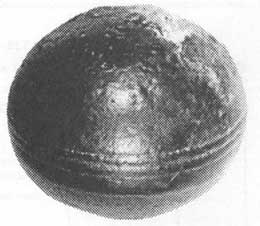
Links
Charles Fort. All strange occurances collected. No explanations. Link